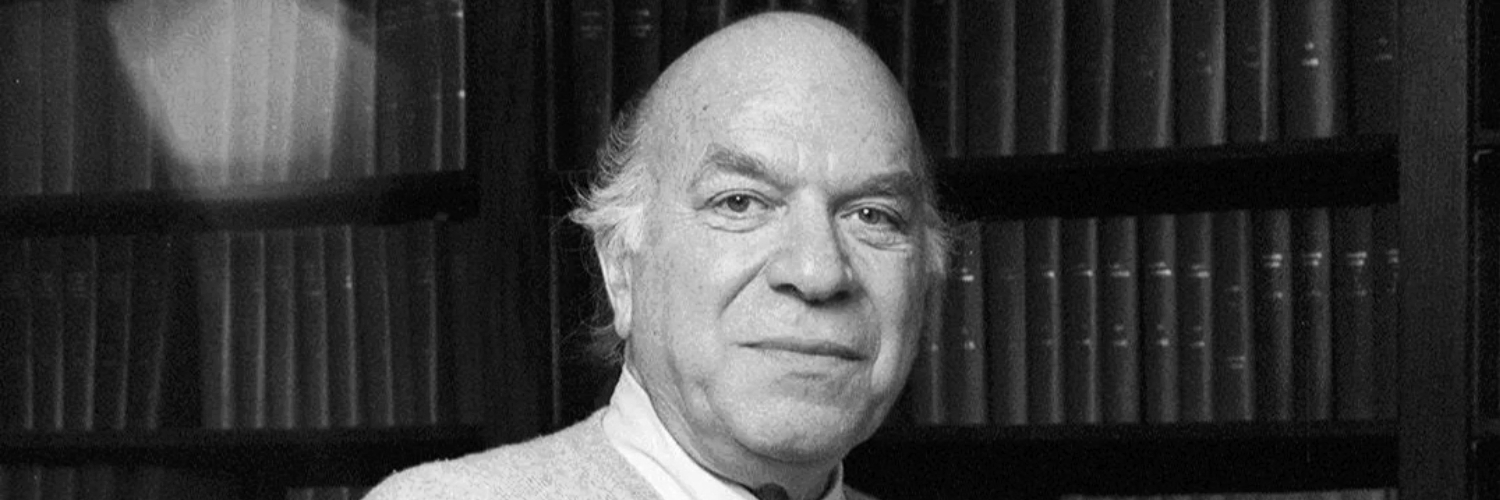In Emma, Frank Churchill begins life as Frank Weston. Jane Austen’s brother, Edward Knight, started life as Edward Austen. Closer to home, Stanley Cavell spent the first two decades of his life as Stanley Goldstein. InLittle Did I Know (2010), Cavell tells the story of how the late adolescent Stan Goldstein performed “the wish to name myself” in wartime California: ‘Family names were irrelevant to the neither serious nor nonserious encounters that made up the seascape with girls the world had become. Stan was all that had been called for. But soon after my inward leave-taking from home [. . .] I introduced myself to a young woman as Stan Cavell. The first two syllables of the family’s original Russian name Kavelieruskii [. . .] broke away as cleanly as if I had flawlessly cut a diamond. (200)’ As he navigates this passage with perplexed parents and the legal bureaucracy, Cavell interprets his action as “declaring the search for a life I could want, not merely endure, in America” (202). He thereby understands it, or offers it to our understanding, as a perfectionist moment or impulse, posing identity on the cusp of the desire for a new life evermore about to be.
Cavell also unpacks this episode under the sign of adoption, “this adolescent’s way of adopting himself” (203). This self-representation as an adoptee builds on an earlier moment in the autobiography, where Cavell reports a sense of himself as an “unfound foundling” (179), as an unclaimed stranger. Cavell thus pinpoints himself on Freud’s map of the family romance, the child for whom identity means inhabiting an adoption fantasy of originating elsewhere, of belonging elsewhere or to someone else. Because skepticism—the ground bass of Cavell’s work—frames humans as strangers to their own circumstances, adoption offers a template for human identity in which there are no natives, always already at home. To be human, from this angle, is to experience selfhood as adopted. In his recent study of transracial adoption, Mark Jerng foregrounds adoption as “the disjunctive act of being taken up into another history and another set of conditions and relationships” (xxi). In Cavell’s episode, adopting the identity “Stan Cavell” is the outward sign of a corresponding act of estrangement, “my inward leave-taking from home.” To leave home is to come home to the homeless condition of being human, what Cavell refers to in his primary texts on Romanticism as “our worldlessness or homelessness” (Quest 32). To exchange Stan Goldstein for Stan Cavell is not to trade a false self for a true self, but to embrace the necessary distance between selfhood and absent origin. Very much like the unsettling ways the marriage settlement circulates in Cavell’s work, adoption beckons in this late autobiographical text as a primary sign of human disjunctiveness and estrangement.
Such a model of the human subject calls out Cavell’s comments on “separation” and “parturition” in The Winter’s Tale: “As if all disseverings are invoked in each; as if to say that life no less than death is a condition and process of dissevering; as if to see each of us ‘demanding and answering to our part’ means seeing ourselves as apart from everything of which we are a part, always already dissevered” (Quest 89). Explicitly yoked to his readings of exemplary Romantic texts, Cavell’s essay on The Winter’s Tale interprets Shakespeare’s manifold figures of separation and parturition under the sign of marriage, as he reads the final scene “as, among other things, a wedding ceremony” (97): “Then let us emphasize that this ceremony of union takes the form of a ceremony of separation, thus declaring that the question of two becoming one is just half the problem; the other half is how one becomes two” (100). Here is a way to think about marriage that underwrites Cavell’s resonantly condensed description of marriage as “the mutual acknowledgment of separateness” (178). Cavell’s reading of the problematic of skepticism in The Winter’s Tale assembles themes of doubt, separation, estrangement, dissevering, and parturition to prepare his ultimate claim that a remarkable idea of marriage is at stake in the ultimate scene. But to understand the primary stakes of the play to be marriage is to elide the ways in which those same themes of separation foreground questions about parents and children as well as spouses. My point is that The Winter’s Tale is also a play about adoption, although that term or its cognates never appear in Cavell’s extensive but subordinated attention to the play’s manifold debates about blood issue, bastardy, and the care of children.
Because marriage and adoption are intricately interwoven in this Shakespeare text that preoccupies Cavell, and especially because Cavell has lately troped a transformative moment in his own life history under the sign of adoption, I propose to track the traffic between marriage and adoption in the context of Cavell’s peculiar traffic with the Romantic writer most notoriously preoccupied with marriage, Jane Austen.
After a review of Cavell’s own recent engagements with texts of Austen, I turn to two novels in particular: Persuasion, which I read as a book about a foundational Cavellian conjugal trope, remarriage, andEmma, which I read as a book about adoption.
Students of Cavell or Austen will not be surprised that marriage is everywhere at issue in these pages. What is new is an emphasis on an Austen novel that Cavell nowhere mentions—Persuasion—and my focus on adoption, whereby I argue that marriage and adoption are twinned events where normative patterns of pairing and kinship are first unstitched and then rewoven in the necessarily elusive forms of Cavellian perfectionism. Especially because Cavell himself—a devoted interpreter of film—has limited his remarks on Austen to the novels alone, I pay particular attention to how a set of Austen films inflect adoption and marriage.
A cornerstone of Cavell’s work is the claim that marriage marks the recalcitrant sites where narratives wrestle with skepticism, and I shape this essay to explore what happens when we extend that large claim to include the unsettling settlements of adoption.
I. Cavell’s Austen
Cavell’s Austen emerges belatedly: “I should confess that I came somewhat late to an unconstrained fascination with Jane Austen” (126). This 2005 observation, in the title essay of the volume Philosophy the Day After Tomorrow, speaks to what for many years seemed a curious gap or a missed opportunity, given Cavell’s long preoccupation with marriage in Shakespeare and in film. Cavell himself flags the untimely sequence, remarking on “the encouraging pertinence of [Austen] to a further region of the work I do, a pertinence I have not felt prepared to broach previously [. . .]. [Her novels] are clear precursors of the preoccupations of the two genres of film that I have devoted books to—genres I name the Hollywood comedy of remarriage and the melodrama of the unknown woman” (119). Whereas Blake was a key figure in Cavell’s early invocations of British Romanticism (as in the final sentences of The Claim of Reason), Austen has become a touchstone in later Cavell.
In the 2010 autobiography, for example, Blake is absent from the index, whereas Austen often assumes a very privileged spot in the roster of Cavell’s lifelong intellectual interests, as in this genealogy of “a specific register of the moral life, one I relate to moral perfectionism, a register running, if largely unheralded, throughout Western philosophy and literature, from Plato and Aristotle through Dante and Montaigne and Jane Austen and Emerson and George Eliot and Nietzsche and Mill to Heidegger and Wittgenstein” (259). At a later moment in the autobiography, Cavell remarks again the special temporality of Austen in his intellectual life: “I do not understand why it was only after philosophy became identifiable for me that after years of all due respect to them, I fell in love with the writings of Jane Austen and of George Eliot” (460).
Cavell’s phrasing of his late return to Austen as “unconstrained fascination” prompts the question of a prior category of constraints, of enforced limits and boundaries. Something there is in Austen that now speaks powerfully to Cavell of the unsettlingly closeted nature of human experience, which is also signified in the way Cavell then proceeds to foreground “distress” (to be pressed upon, unpleasantly) as defining her writing. Nearly all of the commentary on Austen appears in the title essay of the 2005 volume, Philosophy the Day After Tomorrow, where Cavell pairs Austen with Nietzsche: “The spiritual distress registered in Nietzsche, and characteristic of his writing, is not inaccurate to something to be felt in Jane Austen’s prose. You might say that her prose seeks incessantly to minimize (hence maintain) the expression of distress in everyday existence no less drastically than Nietzsche’s seeks to maximize it” (124).
Cavell works out this unusual pairing with brief comments on three novels, Emma, Mansfield Park, and Pride and Prejudice: ‘What invites novels such as Jane Austen’s Pride and Prejudice, Mansfield Park, and Emma, together with George Eliot’s Middlemarch and Daniel Deronda, to this discussion is, in contradiction to much of philosophy, their devotion to the life of the everyday, while at the same time they share, in the texture and turn of every scene, their knowledge of, their craving for, a life lived from what Emerson and Nietzsche call the further self, glimpsed from the perspective of what they picture as life’s higher moments—perfectionist moments. The lives depicted can seem, from a philosophical perspective, too confined or aloof to provide moral inspiration or instruction for a rough world. The experience of the novels is, for many, for me, otherwise. (122)
’ The proposition that Austen’s novels strike many as offering images of human lives that can appear “too confined” lines up with Cavell’s subsequent observation that one of the features of Austen’s fiction that long kept him at arm’s length was “Austen’s narrator’s renowned surface of containment” (124). Constraint, confinement, containment, distress: these are the clouded headings under which Cavell organizes his reading in Austen (and Nietzsche, Emerson, and Eliot) of the “unrelieved routine or fixation of ordinariness” (122), which yields a “state of vulnerable conformity,” a human condition that suffers, in Cavell’s most extreme formulation, “brutalities” (123).
No sunny Austen, this. I return to Cavell again and again in no small measure for his consummate skill as a close reader.
In one of the handful of such exercises Cavell offers from Emma, he zooms in on a sentence—indeed, a phrase—from the opening chapter, and it strikes me as no accident that this is a scene in which Austen herself upends convention by pitching a wedding as a funeral, as an occasion of distress, of vulnerability. As Emma and her father grieve the passing of Miss Taylor into Mrs. Weston, the narrator remarks that this is a moment when “Emma first sat in mournful thought of any continuance” (I.1.4). Here is Cavell’s gloss: ‘I find that I am unsure whether this meditation means that she is vexed not to have her friend to continue their happy mode of existence; or whether it suggests that she is so grief-stricken that she cannot imagine wanting her own existence to continue; or whether, as mostly seems to me the case, that Emma herself cannot tell the difference. (124)’ If I ever paused previously at the phrase “mournful thought of any continuance,” I understood it as a jab at the unlikely prospect that Emma’s thoughts of any kind (even grief) might exhibit duration. But I had certainly never before understood this moment as Emma entirely halted in her tracks, where “continuance” itself is substantively at stake. Lest a reader object that Cavell is overreading “continuance,” here is a sentence from the final chapter of Sense and Sensibility. Edward Ferrars, previously cut off by his mother, is gingerly returning to life: “In spite of being allowed once more to live, however, he did not feel the continuance of his existence secure, till he had revealed his present engagement” (III.14.423). Whereas “continuance” is explicitly at stake in Sense and Sensibility (in both comic and serious registers, as typical in Austen), the fine tuning of Cavell’s ear catches (indeed, brings to our attention) the radical vulnerability of Emma’s new form of confinement and distress.
As Cavell underscores, the wedding that falls on the Woodhouse home like a funeral pitches the stakes of this marriage novel extraordinarily high from the outset. Recalling his reading of “The Rime of the Ancient Mariner” two decades earlier, Cavell unpacks Emma in its opening moments as a narrative poised to unfold, among other possibilities, as what he calls an antithalamion, although he doesn’t put the term into play on this occasion (Quest 65). Cavell is not taken in by Emma’s bluff throughout Volume One that she can exist without marriage, that she can continue her life perfectly well as a single woman and a daughter, a sister, a friend. Compulsory conjugality is not so readily taken off the table under the Hegelian dispensation, wherein marriage is “life in its totality” (Hegel 161).
But instead of the normative epithalamic form in which the culture continues to package and repackage Austen the commodity, the novel Jane Austen wrote opens by foregrounding the dire constraints and confinements of marriage, as if marriage were, in Adam Phillips’s formulation (quoted below in its entirety), a threat instead of a promise (Phillips 98).
These bad consequences include the risk run by Emma, in a few additional words of Austen's spotlighted by Cavell, to be “in great danger of suffering from intellectual solitude” (qtd. in Philosophy 125). In his reading of Austen, Cavell tags the distressing forms of “vulnerable conformity” with multiple figures of limits, boundaries, and enclosures. Those figures also line up with a complementary set of figures of solitude, isolation, separation, and unshareability. Cavell juxtaposes his foregrounded image of Emma Woodhouse at risk with Elizabeth Bennet, focused in a reply Elizabeth makes to Darcy early in Pride and Prejudice, when Darcy has challenged the narrowness (the confinements and constraints) of her social circle: “But people themselves alter so much, that there is something new to be observed in them for ever” (I.9.47). Cavell’s gloss: ‘Now to see something new for ever in the singular persons within an unvarying society—to see, let’s say, from the heightened perspective of an over-morning—is an accurate description of what a writer such as Jane Austen has learned to provide for the world. But this implication of a certain genius reflected in Elizabeth at the same time serves more threateningly to seal her isolation (or loneliness), to show her consciousness to risk being unshareable. (128)’ To be sealed up or sealed off is to suffer the distress of enclosure and constraint, now figured additionally as solitary confinement, as isolation. In these brief comments on Elizabeth Bennet and Emma Woodhouse, Cavell points to the “danger” they everywhere confront in plots busy with the task of “confronting everyday life with itself” (123), as the “perfectionist path exacts the cost of a great separation” (129). The “certain genius reflected in Elizabeth” is Austen herself, and Cavell thus signals that, like many, he reads these two (distressed and vulnerable) heroines as surrogate figures. But unlike the constructions of the Janeite herd, this Austen is no fantasy figure, no light, bright, and sparkling adornment. To locate these characters’ struggles with confinement and the risk of unshareable solitude in the authorial subject is to construct Austen herself as enclosed and closeted.
Cavell’s closeted Austen strikes me as offering an alternative to the most complex construction of Austen in such terms, the picture limned by D. A. Miller.
Both understand Austen’s own identity to be crucially at stake in the fiction. But a key difference between Cavell and Miller comes into focus in how they approach Mansfield Park, the third of the three Austen texts Cavell attends to. In Cavell’s account, Fanny Price joins Emma and Elizabeth in an imperiled trio when he turns briefly to consider slavery in Mansfield Park, “the most lurid of the compromises with an imperfect (to say the least) society shown in Austen’s six major novels” (Philosophy 126). Emphasizing the “economy of horror sustaining the main house of Mansfield Park” (127), Cavell understands Fanny Price under the sign of “Nietzschean convalescence,” a character by design “imperfectly fit for the world as it is because in preparation for a further constitution” (126). Miller, on the other hand, corrals Emma and Elizabeth not with Fanny but with Mary Crawford, in the agon of the unrepresentable authorial subject and her surrogate “stylothetes”: “Though Austen’s typical heroines—Elizabeth Bennet, Mary Crawford, Emma Woodhouse—are all stylists, we are ceaselessly directed to observe the excesses, the failures, even the evils in their performance of style, as though the stylothete were a queen bee who would tolerate no rivals” (Style 42). Cavell understands Emma, Elizabeth, and Fanny as watchful observers rather than high-wire performers. When, following Miller, the motive quest of Austen’s career is enclosed absolutely in the distressed constraints of the (closed) biography, the confinements painfully manifest in Fanny become an unprofitable dead end, especially when Mary Crawford beckons with her “saucy, playful smile” (III.16.531). But to understand Fanny with Cavell as undergoing “convalescence” aims a narrative arc at recovery, however difficult or remote.
In a late section of Monogamy, a set of aphoristic mini-essays about marriage, Adam Phillips poses conjugality not in its positive Hegelian form—to marry is to be born again—but in its negative form, as threat: not to marry is to court death, in two ways: ‘The opposite of monogamy is not just promiscuity, but the absence or the impossibility of relationship itself. Indeed, one reason monogamy is so important to us is that we are so terrorised by what we imagine are the alternatives to it. The other person we fear most is the one who does not believe in the universal sacredness of—usually heterosexual—coupledom. As homophobia, xenophobia, all the phobias tell us: if we don’t choose monogamy our fate will be isolation or the chaos of impersonality. A threat, that is to say, not a promise. Abandonment and exclusion, or getting too mixed up with, and by, other people. In unguarded circulation, or stranded. In other words, we do not know whether we want monogamy, but we do know that we fear excess: an excess of solitude and an excess of company. (98)’ Monogamy throughout frames the Cavellian couple who are willing to gamble on a perfectionist quest that is fraught all the way down, navigating again and again the uncertain daily passages between the terrors of the only other ways to try to be human: alone or lost in a crowd. Cavell pinpoints such perils, such distress, in the worlds of Emma Woodhouse, Elizabeth Bennet, and Fanny Price, constrained and confined, risking isolation, separation, and solitude.
II. Persuasion and (Re)marriage
A hallmark of Cavell’s work on marriage is that there is no such thing as marriage: there is only remarriage, day after day. Here is Cavell’s 1985 summary of his concept of “remarriage,” in the wake of his book-length readings of the idea in Hollywood films and Shakespeare: “The central idea is that the validity or bond of marriage is no longer assured or legitimized by church or state or sexual compatibility or children but by something I call the willingness for remarriage, a way of continuing to affirm the happiness of one’s initial leap, as if the chance of happiness exists only when it seconds itself” (“Capra” 3). Although the word “remarriage” was available in her culture’s lexicon, Austen never uses the term, but she does address this Cavellian inflection of marriage by means of the phrases “first attachment” and “second attachment.” These terms gesture in Austen toward a post-Romantic understanding of marriage as a mode of what Kierkegaard calls repetition and what Cavell invites us to think of as the problem and challenge of the ordinary. In temporal terms, whereas “marriage” traditionally bids to be a lifetime milestone (even if, as now, undertaken in serial instances), Cavellian “remarriage” is a quotidian marker, occurring day after day.
The two novels in which Austen explicitly takes up the question of second attachments are Sense and Sensibility and Persuasion, ironically the two major novels about which Cavell is silent.
In these foregrounded instances of literal second marriages, Austen directs attention to a pressure that everywhere bears upon marriage; as Cavell puts the case, in another context, “the world must be regained every day, in repetition, regained as gone” (Quest 172). In Sense and Sensibility, Austen rigs an elaborate joke at Marianne Dashwood’s expense. Marianne, a devoted romantic, claims that there is no such thing as a second attachment, which elicits her sister Elinor’s wry account of the theory, in a conversation with Colonel Brandon: “How she contrives it without reflecting on the character of her own father, who had himself two wives, I know not” (I.11.66). Because Elinor and Marianne are children of the second marriage, the joke is at Marianne Dashwood’s expense: if she is right and second attachments are “impossible to exist” (I.11.66), Marianne herself is an existential impossibility. From Cavell’s point of view, she has it just backwards—not only are second attachments possible, but they are all there is. Marianne Dashwood is a Cavellian heroine manqué.
Persuasion everywhere recasts the question of marriage as the question of remarriage. Of Anne Elliot, the narrator early in the novel observes, “No second attachment, the only thoroughly natural, happy, and sufficient cure, at her time of life, had been possible to the nice tone of her mind, the fastidiousness of her taste, in the small limits of the society around them” (I.4.30-31). The sentence brims with Cavellian markers: the “small limits” of Anne’s world (the confinement, constraint, and containment that distress Emma, Elizabeth, and Fanny); Anne’s “fastidiousness” and “nice tone of mind” (a certain genius reflected in Anne); and the quest evermore for always elusive perfectionist “cure” (Cavellian “recovery”).
A remarkably large number of characters in Persuasion are on the far side of attachment: Anne Elliot has loved and lost; Sir Walter Elliot is a widower; Lady Russell is a widow; Captain Wentworth has loved and lost; William Elliot is a widower; Mrs. Smith is a widow; Mrs. Clay has returned, mysteriously, “from an unprosperous marriage” (I.2.17); Captain Benwick, unluckily, has even been widowed before marriage. When in Volume Two Anne Elliot heads for Bath, she does not make a new friend but busies herself “renewing” an old friendship, with the crippled Mrs. Smith. The language describing this rehabilitated friendship emphasizes repetition: “The visit was paid, their acquaintance re-established, their interest in each other more than re-kindled” (II.5.166). Having renewed, reestablished, and rekindled their friendship, Anne then revisits Mrs. Smith: “In the course of a second visit she talked with great openness, and Anne’s astonishment increased” (II.5.167). In the world of Persuasion, there are always only second attachments.
Although Cavell’s chief interest in Austen is the way in which her novels render the obstacles to and the risks of the perfectionist quest, he also remarks what he calls “the elation of her novel’s [sic] conclusions” (Philosophy 126). Andrew Miller makes a similar claim at the close of his Cavellian-inflected reading of how Austen’s novels “amplify” narratively the tension between a perfectionist dynamic (through free indirect discourse, we are invited to sympathize with characters who just might be able to accomplish change) and a counter-measure that he calls the “optative” (these characters are locked in a past before which we as readers of an objective narrative are helpless). Miller points to the conclusion of Persuasion as an exemplary instance of how an Austen text points toward a release from the constraints that everywhere define it, remarking “the redemptive exhilaration I find under the otherwise leaden skies of Persuasion: its suggestion that our past can be changed or its effects, at any rate, undone, even as Anne is allowed to undo her past, her refusal of Wentworth, and elicit a second proposal” (135). Cavell and Miller offer a different model for how to read the endings of Austen’s novels: not as the conventionally epithalamic endorsements of normative heterosexual coupling they are so easily taken to be, but as markers of risky, elusive possibilities grounded in a model of the human pair that continues to bear the burdens of distress, a “mutual acknowledgement of separateness” (Quest 178). Because Miller and Cavell similarly testify to how an Austen novel, both in spite of and because of its burdens, can achieve at its end “elation” or “exhilaration,” and because Miller quite rightly (in my judgment) tethers this accomplishment to Persuasion in particular and its constitutive structure of Cavellian secondariness, I want to turn to a privileged Cavellian form and inspect how two recent films adapt the very puzzling final paragraphs of the novel.
One of the abiding oddities of Persuasion is the opaque ending, where it is altogether unclear where the (re)married Wentworth pair will settle down—or perhaps only come to a pause, again and again? (Austen typically does not leave the settlement spot unsettled in the other novels, regardless of their many celebrated exit ironies—what we might call the Pemberley effect demanded of her endings.) The only glancing reference to such a generic close in the final paragraphs of Persuasion is the casual observation that Anne’s old friend Mrs. Smith was “their earliest visitor in their settled life” (II.12.274), a phrase which begs more questions than it answers: settled where? And in what sense “settled”? What’s missing, of course, is an estate name, the force of which formulaic detail is to lock down the couple in a fixed system, a dynamic at odds with an inflection of marriage as remarriage, as reengaged and reinvented, a renewed creation day after day.
The stakes of such endings come into useful focus in two very different film adaptations of Persuasion, the 2007 ITV production directed by Adrian Shergold and the 1995 BBC production directed by Roger Michell. The 2007 Shergold Persuasion offers an arrestingly fumbled re-reading of the conclusion. Wentworth takes a blindfolded Anne (not a good sign) to her new married home, which is—impossibly—the Elliot ancestral home, Kellynch Hall, and the film’s final image is their wedded dance in the forecourt of the (mysteriously) recovered family estate.
Instead of remarriage, the film foregrounds a refinanced property. The unmoving house looms large over the dancing couple who twirl in embrace about a fixed spot, and the carriage which has conveyed them there, mobile, is now parked irrelevantly to the side.
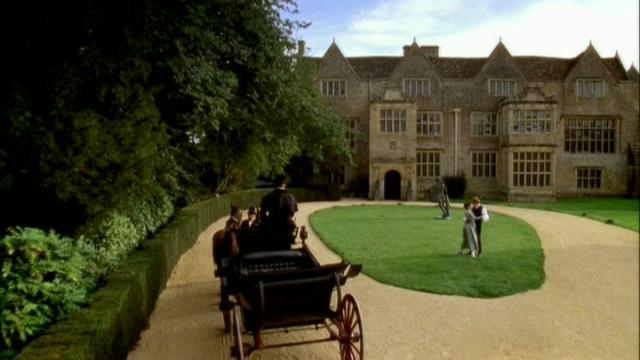
In contrast, the conclusion of the 1995 Michell Persuasion locates the Wentworth couple on board a ship, which is as smart a guess as any concerning their “settled life”—if a guess is required. This image of a seafaring couple is also consonant with another key structure in the novel, the unconventional Croft marriage as an ideal for the Wentworth pair: the Croft marriage, much of which has been spent at sea, is chronically on the move. This (re)married couple gaze not at one another (nor do they twirl in embrace about a fixed spot), but they gaze, separately, in different directions. The rigging upon which they lean picks up one of Austen’s navy jokes in the novel (“the little knot of the navy”), for it is the notable skill of this branch of the military—Austen’s favorite branch, as a loyal sibling—to tie knots, and this remarriage knot is tied in new ways that open upon new futures, possible and perfectionist.
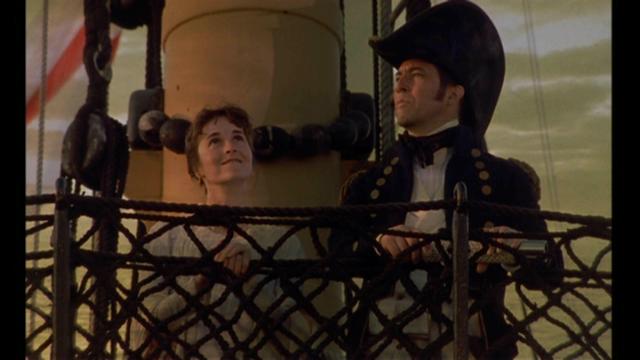
This image of Anne and Wentworth on deck, which I read as a Cavellian inflection of the married pair, is not the film’s ultimate shot, however, and the final image pulls back from the (re)married couple to offer a long view of the full-rigged ship, which now replaces the landed estate as a new mobile form of the fixed settlement spot.

The risk of this narrative strategy is to freeze the ship’s motion at anchor in an apparently new settlement system, but a system that offers distinction without difference. A prevailing understanding of Persuasion is that the Croft and Wentworth marriages refigure in a postwar mode of emergent bourgeois professionalism the residual landed virtues of Pemberley. Marriage and virtue, once fixed, are now free to wander. But I want to suggest that Austen shapes Persuasion to contest the epithalamic mandate on several fronts. To substitute mobility for fixity as the foundation of marriage is to continue to insist upon an unshifting foundation. To understand the Wentworth marriage as a postwar Pemberley-to-go is to continue to credit the centripetal force of the marriage refuge. In its elaborate counterpoint of motion and stasis, Persuasion the novel instead works toward a style of marriage writing that inclines marriage toward remarriage, attachment toward reattachment, over and over, day after day, sentence after sentence. It unsettles the marriage settlement. The 1995 Michell film at its end verges upon this Cavellian dynamic of the novel, before pulling back and away. The ending of a different film, the 2009 BBC Emma, approaches more closely a perfectionist Cavellian period.
III. Emma, Adoption, and Marriage
The 2009 BBC Emma, directed by Jim O’Hanlon from a screenplay by Sandy Welch, is a remarkable adaptation in any number of ways, but especially in its framing moments, at opening and close. Instead of launching the film in lockstep with the novel (the aftershocks at Hartfield of the marriage of Miss Taylor to Mr. Weston, which registers on Emma and Mr. Woodhouse as a funeral—those moments that Cavell finds so telling), O’Hanlon foregrounds in his opening images a set of very different and very dark events from the novel’s various backstories: the death of Emma’s mother, the death of the first Mrs. Weston, and the death of Jane Fairfax’s mother. At the other end of the film, O’Hanlon again plays fast and loose with one of the novel’s most famous structures, the supremely self-contained world of Highbury. In the film, the spatial surround of the Emma Woodhouse-George Knightley marriage settlement is not tethered to the intensely local question of whether the couple will live at Donwell Abbey or at Hartfield, as in the novel. Instead, O’Hanlon closes by taking the married couple on the road on their wedding trip to the sea, breaking the celebrated narrative frame that is Highbury. I propose that both of these framing revisions adapt Emma as a narrative with noteworthy Cavellian inflections, pointing toward a human world in which adoption and marriage are isomorphic forms available, however elusively, to the perfectionist quest.
I have elsewhere argued that Emma is usefully read as a novel about adoption.
Three of the main characters—Frank Churchill, Jane Fairfax, and Harriet Smith—are untethered from their birth families, and this unusual surplus gives redundancy signifying force: surrogate families rival consanguineous sets in the world of this novel. The contingencies of adoptive families run unsettlingly counter to the constraints of the closed systems of blood kinship that underwrite identity and power in manifold ways in Austen’s world.
Bastards (Harriet Smith), orphans (Jane Fairfax), and semi-orphans (Frank Churchill) line up as a disruptive adoptive set with other creatures on the margins of Highbury: old maids (Miss Bates), widows (Mrs. Bates), governesses (Miss Taylor), yeoman farmers (Robert Martin), and threatening bands of gypsies. Although all three adoptive narratives in Emma take their origins in deaths (Frank and Jane) or the mysterious shadows of illegitimacy (Harriet Smith), these haunted plots also mark spaces where new futures might be imagined in perfectionist glimpses. In short, I want to line up adoption in Emma with how Cavell as autobiographer understands his decision to change his own name as a form of adoption, as a “search for a life I could want.”
The O’Hanlon Emma narrates these three opening moments as scenes of separation and parturition, as leavetakings from home. Instead of a wedding that falls upon Hartfield as a funeral, the film opens with the death of Emma’s mother. The young Emma Woodhouse is posed beside her mother’s coffin:
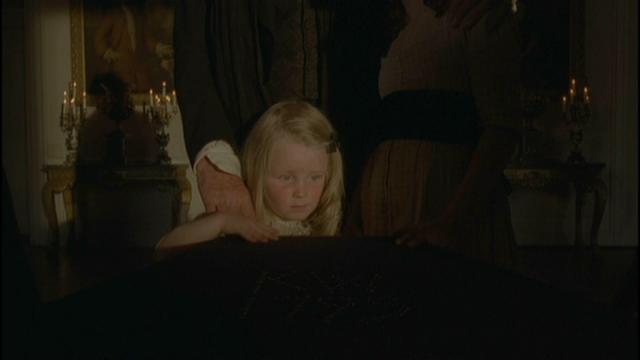
Fast on the heels of this foundational sorrow, the film cuts to the first image of adoption. Mr. Weston is at the bedside of his dead wife, and their son Frank is at the door with his aunt, Mrs. Churchill (the sister-in-law of Mrs. Weston), who will now, in the language of the novel, “take the whole charge of” Frank (I.2.14), who grows up not as Frank Weston but as Frank Churchill.
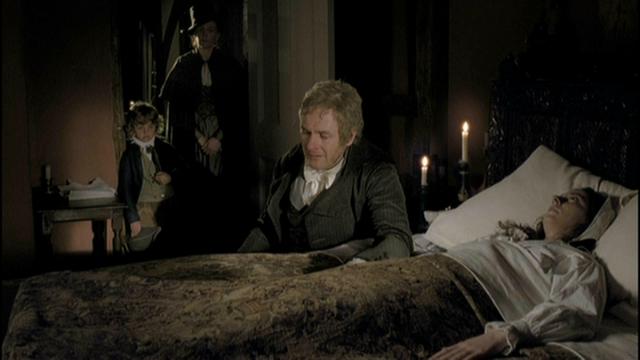
Instead of foregrounding this tale of adoption, the novel offers it as backstory information in the second chapter, and the episode in the novel is also geographically distant from Highbury: the young Mr. Weston is serving in the military in Yorkshire when he marries a Miss Churchill, and Yorkshire is where Frank grows up at his new adoptive home, Enscombe, the Churchill family seat.
But the O’Hanlon film locates the adoption episode in Highbury itself, and these narrative rearrangements work to yoke more directly than does the novel the fates of two young citizens of Highbury who have both lost their mothers. The effect of this pairing is to locate under the sign of adoption the marriage plot that will soon entangle both these characters. As Frank Weston disappears into the carriage in which he exits Highbury to take up his new identity as Frank Churchill, the camera frames his face staring through a rain-drenched back window at his tearful father bidding him farewell, Frank’s hand raised to steady himself as the carriage lurches forward and to reach back toward the brief opening chapter of his life that has already closed, an echo of the young Emma’s hand on her mother’s coffin.
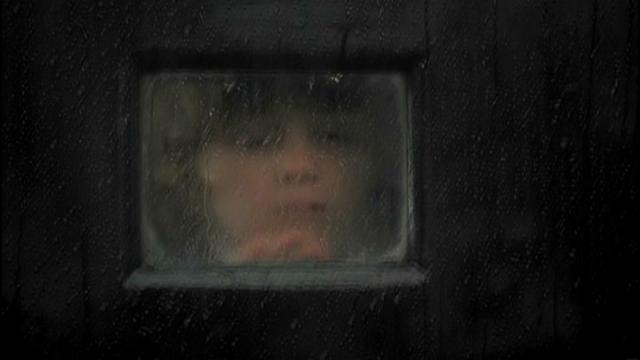
Immediately following the death of Emma’s mother and the death of Frank Churchill’s mother, the O’Hanlon film turns to foreground a third piece of the novel’s backstory, the death of Jane Fairfax’s mother. The novel delays this narrative background until much later, the second chapter of Volume Two, when Colonel Campbell makes the offer “of undertaking the whole charge of her education” (II.2.175), which translates into a de facto adoption of Jane from her Highbury kin, Miss Bates (her aunt) and Mrs. Bates (her grandmother). Once again we see the adoptive child conveyed away from Highbury in a carriage, and Frank Weston and Jane Fairfax are now joined visually by the occasions and modes of their leave-takings.
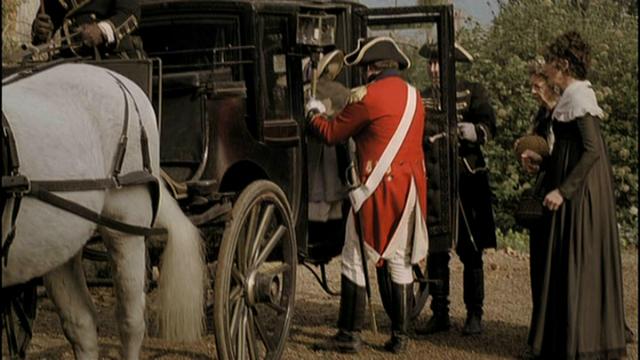
As the marriage plot driving the narrative enlarges its net to include Jane, the O’Hanlon film continues to signpost the first stirrings of that plot with scenes of adoption, a primary means whereby Austen’s culture manages parental deaths and the care of children. There is no better anchor in the novel itself for these cinematic rearrangments than that early phrase descriptive of Emma that catches Cavell’s attention, “mournful thought of any continuance” (I.1.4). For these children, the future itself is immediately and grimly at stake: after such deaths, what continuance? The contingencies of adoptive identity—not only its dire necessities but also its fragile possibilities—will fall upon them a second time as adults in the contingencies of marriage.
At the other end of the film, O’Hanlon offers another dramatic departure from the book’s narrative template. Emma the novel is by design an experiment in how Austen’s famous narrative boundaries, “3 or 4 Families in a Country Village” (Letters 275), can help a plot achieve escape velocity precisely to the extent that those boundaries are sharply drawn and unbroken, reflecting what Cavell calls their “surface of containment.” Emma begins and ends in Highbury and takes its being therein. The famous final phrase, “the perfect happiness of the union” (III.19.528), brings the marriage plot to its perfected close and simultaneously snaps the gate shut on the small world that is Highbury, by which paradoxical means the novel becomes an available world. O’Hanlon breaks this frame and takes the film on the road in its closing shots, following Emma and Knightley on a wedding trip to the sea.
I was startled at first viewing because the narrative costs on this score are so high, but I now view these images as abundant recompense, especially as they open the film into the contingent Cavellian territory of perfectionist possibilities.
Post-Highbury, Emma and Knightley in the film are first framed together in a carriage. In terms of both the novel and the film, this image most readily invites understanding as a triumphant revision of Emma’s vexed carriage ride with Mr. Elton at the close of Volume One.
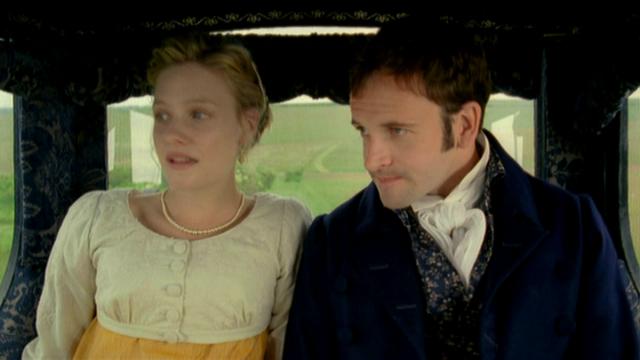
But in O’Hanlon’s full cinematic setting, the image also stretches back to the carriages that convey Frank Weston and Jane Fairfax to their adoptive futures, lining up adoption and marriage as twinned vessels of the perfectionist quest, as both forms wrestle to free themselves from necessity in order to face the fearful risks of contingency.
Freed from the carriage, the next image offers Emma and Knightley, backs to the camera, hand in hand, walking over the downs toward the sea.
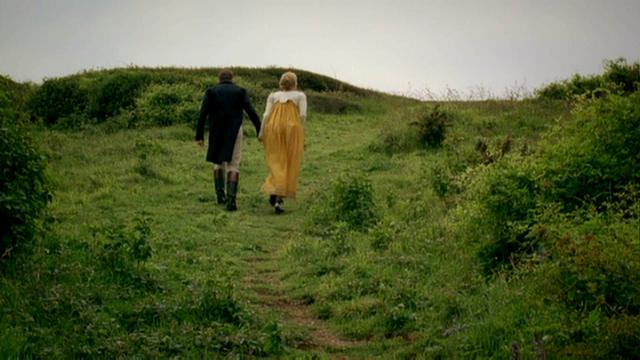
I return to Cavell for a gloss on this image. Several years after the publication of his major work on “comedies of remarriage,” Pursuits of Happiness (1981), Cavell published a short essay, “A Capra Moment,” returning to one of the exemplary films in that book, Frank Capra’s It Happened One Night, but on this occasion singling out a “moment whose apparent commonplaces and evanescence found no place in my long and difficult chapter on the film” (3). That “moment” is, simply, this: “a man and a woman are walking away from us down an empty country road” (3). Cavell then reads this Capra moment as a compound of four key markers, “away from us / together / walking / on the road,” which together compose, for Cavell, a “wedding photo,” with the special inflections by which Cavell understands (re)marriage: “the centered walk away down the road [. . .] does also feel like something is ending, hence like something is beginning, some border being crossed. It is this undefined openness, as if leaving the past behind them, that marks this particular inflection of vulnerability, of thoughtful anticipation” (5). I find these dynamics reproduced in O’Hanlon’s penultimate image of Emma and Knightley, moving away from us, together, walking, on the road. The “particular inflection of vulnerability” in the film at large is the vulnerability not only of the risk known as marriage but also the risk known as adoption.
Before turning to the final image in O’Hanlon’s Emma, I want to contrast another late image in a recent film of Sense and Sensibility in order to foreground the ways in which the ultimate Emma image smartly refigures signposts of the marriage empire. In the 2007 BBC adaptation of Sense and Sensibility, the director John Alexander and screenwriter Andrew Davies pose Elinor Dashwood alone by the sea, seated on a bench, with her back to the viewer.
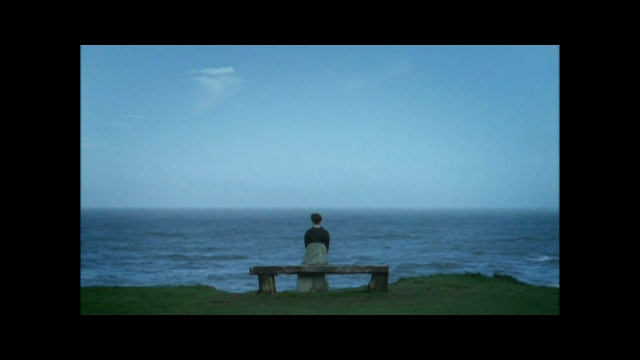
This image is staged after the return to Barton, after Marianne’s recovery but before Edward Ferrars arrives to stumble toward marriage. Elinor is seated on the bench ever so slightly off center, inviting the thought of what absent other might fill an empty spot close beside her in a composition of balanced symmetry. Post-Sedgwick, reading the vectors of desire in Sense and Sensibility can never again fixate on heterosexual marriage as sole available telos. Like Elinor herself in the image, Elinor’s desire, autocentric and allocentric, faces elsewhere, elusively. And were she standing there alone, the scene would be a wrap, on these notes. But she is not entirely alone, and that’s my point: there is the bench to account for. Unremarkably, the bench marks the grounded and settled spot where the marriage empire summons identity to take seated place, with room for one other.
Unremarkably, a bench also marks widely and deeply in the language the weight of communal and judicial authority, signifying here the foundational regime of coupledom that arranges the solitary Elinor in a position that demands a paired companion. Edward Ferrars will soon fill that spot, although the final paragraph of the novel has great sport with the thought that Marianne and Brandon crowd their way on the bench as well.
To close O’Hanlon’s Emma, Knightly and Emma, walking away from the viewer, clear the dunes and arrive, like Elinor, by the sea. The final image is a long shot from behind of the pair gazing out over the coast.
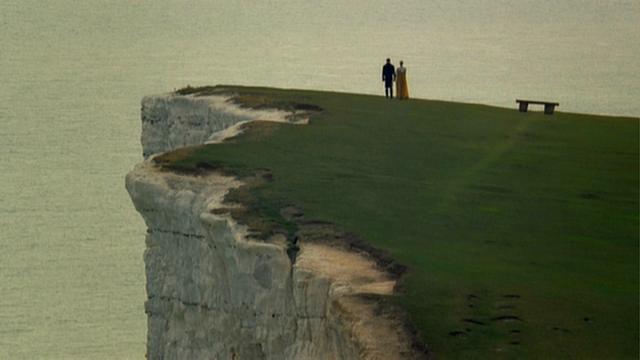
It is a place manifestly not without vulnerability, without risk—those cliffs!—but the scene is simultaneously suffused with the calm of the (momentarily) untroubled expanse of water. As in the image in Sense and Sensibility, the bench on the right marks the fixed settlement spot, but in this image it is, remarkably, empty. The faint track across the field to that bench confirms the power of the marriage empire, but the image also offers, disruptively, vanished traffic and an empty destination. The human pair to the left are set apart from that authoritative anchor, not seated of necessity (or by birth) in the old order but standing together in a shared difference, gazing away from the viewer into an unwritten future. In a different context, Cavell will define their attitude as “the mutual acknowledgement of separateness” (Quest 178). In Emma—the novel and especially the O’Hanlon film—separateness is a characteristic of the human condition that is located under the sign of adoptive identity. The novel and the film offer a human world in which adoption and marriage are isomorphic forms suffered by and available to, however elusively, the perfectionist quest. I take that thought as license to superimpose a different narrative on this final image: to the right, we see a fixed place benchmarked for someone named by others Stanley Goldstein. To the left, standing aside, there is a place for someone who names himself, adoptively, Stan Cavell. It is the human fate of both the California ephebe and the Regency couple—adopted, (re)married—to remain apart from everything of which they are a part.

